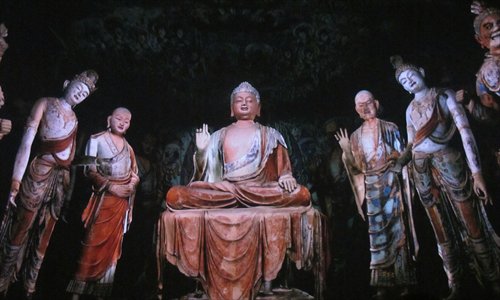
A scene from Mogao Grottoes: A Brilliantly Painted Visit of a Buddhist Paradise Photo: Xu Liuliu/GT
For travelers who love to take in art and culture, lining up for hours to view a single painting or other work of art is a special annoyance, especially during peak travel seasons. Now one of China's most well-known world UNESCO cultural heritage sites, the Mogao Grottoes, is looking to remove that annoyance altogether with its new visitor center.
Officially opened on Wednesday after a month-long trial operation, the center now requires all individuals and groups to make a phone or online reservation before visiting the 1,600-year-old caves located near Northwest China's Dunhuang city, Gansu Province. Before entering the Buddhist shrine with its 492 cells and caves featuring Buddhist statutes and wall paintings, visitors will be shown two short films that introduce the history of Dunhuang and provide a general background to the site.
"These new measures along with the use of high-technology will increase our maximum daily reception capacity from 3,000 to 6,000 people," said Fan Jinshi, head of the Dunhuang Academy, during the opening ceremony for the center.
The academy heads research, protection and management of this cultural heritage site.
According to Fan, one of the two films - A Thousand Years of Mogao, shown in 4K resolution - focuses on the long history of Dunhuang and glorious past of Mogao, while Mogao Grottoes: A Brilliantly Painted Visit of a Buddhist Paradise, which is projected on a huge dome theater, gives a full view of the wall paintings and Buddhist statues in caves that are either closed for reservation or too dark to see clearly even with the help of lights.
Li Ping, director of the Mogao Grottoes Visitor Center, told the Lanzhou Morning Post that the short film provides a clearer view of the caves not open to the public, and from better angles as well.
"The experience is even better than standing in the cave and seeing things with your own eyes," she said.
After visitors watch the two films, they will be transferred by shuttle bus to the actual caves where they can appreciate the numerous wall paintings.
The staff at the center explained that an excessive amount of visitors to the caves at one time can change the temperature of the caves, humidity and carbon dioxide density, which can in turn damage wall paintings and statues.
As such they consider this new visitation model an effective way to limit the damage to the grottoes, by reducing the time visitors are allowed to spend in the caves, while also allowing visitors to fully appreciate the art of Mogao.
